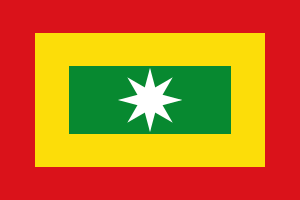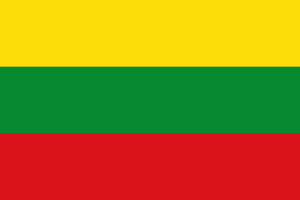First Republic of New Granada facts for kids
The First Republic of New Granada was a time in the history of Colombia. It lasted from 1810 to 1816. This period began right after Colombia declared its independence from Spain. It ended when Spain took back control of the region.
People sometimes called this time the Foolish Fatherland (la Patria Boba). This was because there was a lot of fighting. Different groups argued about how the new government should work. Some wanted a strong central government (centralists). Others wanted provinces to have more power (federalists). This constant fighting made the new country weak. It also made it easier for Spain to reconquer the land.
Contents
Forming New Governments: 1810
In May 1810, big news arrived from Spain. Napoleon's army had taken over southern Spain. The main Spanish government council had broken up. Also, new local governments, called juntas, had formed in Venezuela.
When this news reached New Granada (which is now Colombia), cities started forming their own juntas. A junta was a special council or committee. It took over the government in a city or region.
A Spanish official named Antonio Villavicencio arrived in Cartagena on May 8, 1810. He found the city in a state of political confusion. Villavicencio helped the city council call for an "open cabildo." This was a meeting where important citizens could discuss things. This meeting led to the creation of many provincial juntas.
On May 22, 1810, Cartagena formed its own junta. This new government replaced the old Spanish governor. Other cities quickly followed. Cali formed a junta on July 3. Pamplona did so the next day. Socorro followed on July 10.
The capital city, Santa Fe de Bogotá, formed its own junta on July 20. This day is now celebrated as Colombia's Independence Day. The Spanish viceroy, Antonio José Amar y Borbón, first led the Bogotá junta. But he was removed from power five days later due to public demand.
More juntas appeared in other cities. These included Honda, Antioquia, Popayán, Neiva, Quibdó, Nóvita, and Tunja. Soon, smaller towns also wanted more power. For example, Mompós declared independence from the Cartagena junta on August 6.
These new juntas said they were still loyal to King Ferdinand VII of Spain. They also pledged loyalty to the Catholic Church. But the Bogotá junta called itself the "Supreme Junta of the New Kingdom of Granada." This showed it wanted to be in charge. However, many cities created their own juntas and claimed to be independent. This led to many small conflicts. There were also two failed attempts to create a congress of all the provinces.
First Independent States and Civil War


The new local governments, or juntas, helped transfer power peacefully at first. But they soon caused problems and divided the land. In New Granada, leaders in different cities disagreed. Some supported the new independent governments. Others supported King Ferdinand VII and the Spanish authorities.
Spanish officers and their supporters, called Royalists, took control of cities like Santa Marta, Panamá, Popayán, and Pasto. These Royalist areas then fought against the regions with independent governments. Even though the Royalists were often weaker, they caused a lot of trouble. They kept the idea of rejoining Spain alive. They also used up the resources and energy of the independent governments. These divisions stopped New Granada from becoming a single, strong country.
The provincial juntas also argued about what kind of government the new state should have. Should it be one single state? Or should each province be an independent state? The "Supreme Junta of Santafé" (in Bogotá) thought it should lead. Bogotá was the largest and richest province. It had been the center of Spanish rule.
The Cartagena junta wanted a different plan. It called for a meeting where each province would have a say. The Santafé junta responded by inviting provinces to send delegates to form a temporary government. They also wanted to create a Constitutional Assembly for all of New Granada.
This congress was not very organized. Only a few provinces sent delegates. They argued about whether smaller towns should count as provinces. In this congress, Antonio Nariño wanted to set up the main government in Santafé. But other provinces did not agree. They saw this as Santafé trying to take too much power. The congress eventually broke up due to disagreements.
Meanwhile, the province of Santafé became a state called the Free and Independent State of Cundinamarca. In March 1811, it created a constitution. This constitution was similar to the Constitution of the United States. It made Cundinamarca a constitutional monarchy under King Ferdinand VII. Cundinamarca only declared full independence from Spain in August 1813.
Cundinamarca tried to expand its power. It tried to take over nearby regions. It also tried to make alliances with Venezuela. This was to balance the power of big provinces like Cartagena. During this time, Antonio Nariño strongly opposed the idea of federalism. He wanted a strong central government in Santafé. Nariño started a newspaper called La Bagatela in July 1811. He used it to share his ideas against federalism. Nariño became president of Cundinamarca in September 1811. He pushed for a centralized republic.
After a failed attempt by Royalists to take power, Cartagena became the first province in New Granada to declare full independence from Spain. This happened on November 11, 1811. This day is now a national holiday in Colombia.
The "Congress of the United Provinces" started meeting again. Even though Cundinamarca was against it, the Congress agreed on something important. On November 27, 1811, they created the Act of Federation of the United Provinces of New Granada. Camilo Torres wrote this act. It was signed by delegates from five provinces.
This Act created a group of equal and independent states. They were called the United Provinces of New Granada. Each state would have its own elected government. It would handle its own laws and daily affairs. The Act also gave some power to the General Congress. This Congress would deal with common defense, international relations, and war. A very weak president position was created, who would report to the congress. However, this Act did not unite New Granada completely. Cundinamarca strongly opposed it. This made the differences between centralist and federalist ideas even stronger.
Nariño and his supporters strongly opposed federalism and the Congress. They believed Cundinamarca's power would allow it to unite New Granada. Nariño tried to change Cundinamarca's constitution to make it more centralist. He also tried to add nearby provinces like Tunja, Socorro, Pamplona, Mariquita, and Neiva. But he was mostly unsuccessful.
The members of the Congress had to leave Bogotá because of Nariño's actions. They moved to Leyva and then to Tunja. Cartagena became the main rival to Nariño's centralist ideas.
The conflict between Nariño's centralist group and the federalist group in the Congress (led by Torres) grew. It spread to their regions. The Free and Independent State of Cundinamarca and the United Provinces of New Granada (now in Tunja) fought constantly. This led to a Civil War.
Nariño ordered General Antonio Baraya to defeat the federalist leaders in Tunja. But Baraya switched sides and joined the federalists. Many important leaders like Santander and Caldas joined him. Baraya and his rebels declared Nariño a tyrant. They pledged loyalty to the Congress. Nariño then asked Cundinamarca's government for special powers. This allowed him to become a dictator.
On November 26, 1812, Nariño marched his army to conquer Tunja. On December 2, 1812, his army fought a federalist army. This was at the Battle of Ventaquemada. Nariño's army was defeated and had to go back to Bogotá. The federalist troops chased them more than a week later. This gave Nariño's troops time to plan their defense. Baraya's troops surrounded Santafé on December 24. On January 9, 1813, Nariño's troops won the Battle of San Victorino. The federalist armies were completely defeated.
This first civil war ended in a kind of tie. But it allowed Cundinamarca to send an army against the Royalist regions of Popayán and Pasto. This happened in July 1813. Nariño led his 'Army of the South'. He captured Popayán in January 1814. But he was then defeated by Royalist forces in Pasto. He was arrested in May 1814 and sent to a Spanish prison.
Nariño's capture weakened Cundinamarca. The United Provinces took this chance to send an army against it. This army was led by Simón Bolívar. Bolívar had fled Venezuela after his own defeat there. Bolívar and his army forced Cundinamarca to join the United Provinces by December 1814. Meanwhile, Cartagena had been fighting the Royalist city of Santa Marta. Cartagena was in chaos after its defeat.
Aftermath: Spanish Reconquest of New Granada
By the end of 1814, the provinces were very weak. They had been made poor by the civil wars between federalists and centralists. They also fought against Royalist cities. Many people in the newly independent provinces had never fully rejected King Ferdinand VII. Also, the way of life and culture in the provinces was still very Spanish. The Catholic Church mostly opposed independence.
In mid-1815, a large Spanish army arrived in New Granada. This army was led by Pablo Morillo. It helped the Royalists who were already advancing from Santa Marta. Morillo surrounded Cartagena in August. The city finally fell five months later in December. Many people in Cartagena died from hunger and disease during the siege.
By May 6, 1816, Morillo and Royalists from the south had conquered Bogotá. This put all of New Granada back under Spanish control. Spanish rule lasted until August 1819. That's when forces led by Simón Bolívar took back the central part of the region.
See also
- Spanish American wars of independence
- History of Colombia
- Viceroyalty of New Granada
- United Provinces of New Granada
- Gran Colombia
- Antonio Nariño
- Spanish reconquest of New Granada
- Bolívar's campaign to liberate New Granada
 In Spanish: Patria Boba para niños
In Spanish: Patria Boba para niños



